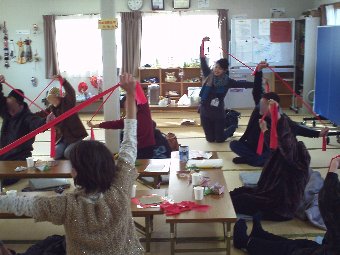Great Eastern Japan Earthquake
Fukushima Sousou Project Medical Work on the Ground Report 3

I took part in salon activities in Minamisouma, Fukushima during this visit too, which was at the end of February, almost exactly two years since the disaster.
The salon activities take place in the morning at a community center that faces Minamisouma port where many locals from the Haragama district gather.
Residents write notes on their mental and emotional well-being that day through such things as ‘face sheets’, taking their blood pressure and so on, with the cooperation of staff from the Souma Wider Region Mental and Emotional Well-Being Center Nagomi.
This time, I listened to the residents as they made some simple craft work – pasting their favorite origami onto paper cups, making hina dolls etc.
Most of the people who gather were elderly women, and most of their husbands had been fishermen. Before the disaster, they had worked with their husbands by mending nets, or working in fish processing plants. One woman said that she sometimes has dreams of those days of working together. Most of their husbands no longer work as fishermen and instead work in facilities that process debris from the disaster.
As soon as one lady said that she hopes they can quickly return to the good old days of a vibrant fishing community, another said that it will never go back to how it was then. Not just because of the issue of rebuilding fish processing plants, but also because of people’s aversion to buy products which they are afraid might be contaminated with radiation, even though there is no evidence of such. So even if the plants reopen, it will be impossible to sell their fish. One lady said casually “Not even my own son will eat fish caught in Souma. Unbelievable isn’t it?” but behind the facade you could tell that this saddens her. In the afternoon, I joined another salon activity in a temporary accommodation neighborhood populated mostly by former residents of Iidtate Village. After the disaster, all residents of the village were forced to evacuate.
After taking their blood pressure and doing some light exercises with stretch bands, I listened to their stories while we folded origami together. “I had over X number of cattle, but I simply gave them all to a farming acquaintance in another prefecture. If I had tried to sell them on the market I would have gotten a terribly low price for them, so, I guess giving them away was ok.” “We are a farming family so it goes without saying that we never had to go to the supermarket to buy vegetables. We were busy picking and harvesting them from our fields every day. But now in the temporary housing neighborhood, we’re bored because we have nothing to do. At the most, we go back to Iitate every other day or so to put out some food for the dogs and cats there. Hmm, the animals really are so cute.” These are just some of the thoughts going through their minds.
Both the people of Haragama district and Iitate village are passing their days by living in temporary accommodation, uncertain about the future – wondering how much longer they will have to live in temporary housing and if things will ever go back to the way they were before the disaster.
But, they have not been forgotten. This is the message I want to make sure they receive, and I hope to continue supporting them through this aid work.
Medecins du Monde Nurse Kamiyama Yuri
